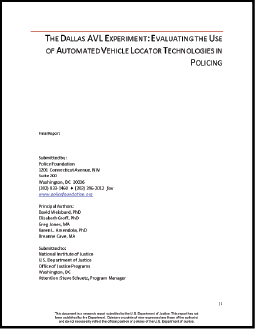
This study, using a blocked randomized experimental design, found that, at least in cites like Dallas with large geographies, automated vehicle locator (AVL) information will not aid patrol allocations in large geographic areas. This is because patrol coverage in beats is largely a function of cross-district dispatch to specific incidents rather than commander-directed deployment; however, AVL is effective in achieving higher levels of patrol as needed in “hot spots” of crime as determined by crime mapping. This resulted in significant reductions in crime. Additional studies are needed in other cities, with a focus on the management of patrol presence in hot spots. This should provide a better understanding of the potential benefit of using AVL for timely location of patrol presence. The study identified four groups of beats with similar crime trajectories using trajectory analysis. Each of the beats within a trajectory group was randomly allocated to treatment or control conditions. Commanders received information on the measured deployment levels (the amount of hours of vehicle presence as measured by an AVL received by the treatment beats but not the control beats). In addition, they received AVL measured deployment information about Compstat hot spots in the treatment areas, but not in the control areas.
